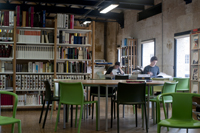| Titre : | Two Minutes of Standstill : a Collective Performance by Yael Bartana ; Impulse Theater Biennale | | Type de document : | texte imprimé | | Auteurs : | Florian Malzacher (1970-....), Editeur scientifique ; Stefanie Wenner, Editeur scientifique | | Editeur : | Londres : Sternberg Press | | Année de publication : | 2014 | | Importance : | 1 vol. (81 p.) | | Présentation : | ill. en coul. | | Format : | 28 cm | | ISBN/ISSN/EAN : | 3-956790-61-8 | | Prix : | 20 EUR | | Note générale : | Performance-Datum ermittelt: June 28, 2013 at 11 a.m. as part of the Impulse Theater Biennale in the city of Cologne | | Langues : | Anglais (eng) | | Mots-clés : | performance Holocauste commémoration | | Index. décimale : | MON Monographie | | Résumé : | Contemporary ideas of history have bid farewell to the concept of one big narration as a hegemonic product that excludes other histories. With regard to the Holocaust this means that individual biographies of victims and testimonies from eyewitnesses form the archival corpus of this history. But using individual testimonies as historical revelation is not enough.
Inspired by the Israeli memorial day Yom HaShoah, the holiday that commemorates victims and resistance fighters of the Holocaust, Yael Bartana’s Two Minutes of Standstill took place on June 28, 2013, at 11 a.m., as part of the Impulse Theater Biennale in the city of Cologne. A symbolic interruption of everyday life, Two Minutes of Standstill was a political act, a social sculpture, and a collective performance. Historically, the act of a silent standstill is a way to commemorate the dead. Bartana’s artwork, however, also calls for a reflection on the present. During the preparation for the performance a range of reactions occurred that were both positive and critical. What does the specific way this history is told in Germany tell us about the country today? And why did Bartana’s performance provoke such strong reactions?
This catalogue is a documentation of Two Minutes of Standstill, revealing the ideas behind the work and the process that led to its realization. The book includes several essays that discuss possible interpretations and consequences of the artwork, questioning the role of history and commemoration in Germany today. |
Two Minutes of Standstill : a Collective Performance by Yael Bartana ; Impulse Theater Biennale [texte imprimé] / Florian Malzacher (1970-....), Editeur scientifique ; Stefanie Wenner, Editeur scientifique . - Londres : Sternberg Press, 2014 . - 1 vol. (81 p.) : ill. en coul. ; 28 cm. ISBN : 3-956790-61-8 : 20 EUR Performance-Datum ermittelt: June 28, 2013 at 11 a.m. as part of the Impulse Theater Biennale in the city of Cologne Langues : Anglais ( eng) | Mots-clés : | performance Holocauste commémoration | | Index. décimale : | MON Monographie | | Résumé : | Contemporary ideas of history have bid farewell to the concept of one big narration as a hegemonic product that excludes other histories. With regard to the Holocaust this means that individual biographies of victims and testimonies from eyewitnesses form the archival corpus of this history. But using individual testimonies as historical revelation is not enough.
Inspired by the Israeli memorial day Yom HaShoah, the holiday that commemorates victims and resistance fighters of the Holocaust, Yael Bartana’s Two Minutes of Standstill took place on June 28, 2013, at 11 a.m., as part of the Impulse Theater Biennale in the city of Cologne. A symbolic interruption of everyday life, Two Minutes of Standstill was a political act, a social sculpture, and a collective performance. Historically, the act of a silent standstill is a way to commemorate the dead. Bartana’s artwork, however, also calls for a reflection on the present. During the preparation for the performance a range of reactions occurred that were both positive and critical. What does the specific way this history is told in Germany tell us about the country today? And why did Bartana’s performance provoke such strong reactions?
This catalogue is a documentation of Two Minutes of Standstill, revealing the ideas behind the work and the process that led to its realization. The book includes several essays that discuss possible interpretations and consequences of the artwork, questioning the role of history and commemoration in Germany today. |
|  |


 Ajouter le résultat dans votre panier Affiner la recherche
Ajouter le résultat dans votre panier Affiner la rechercheTwo Minutes of Standstill


